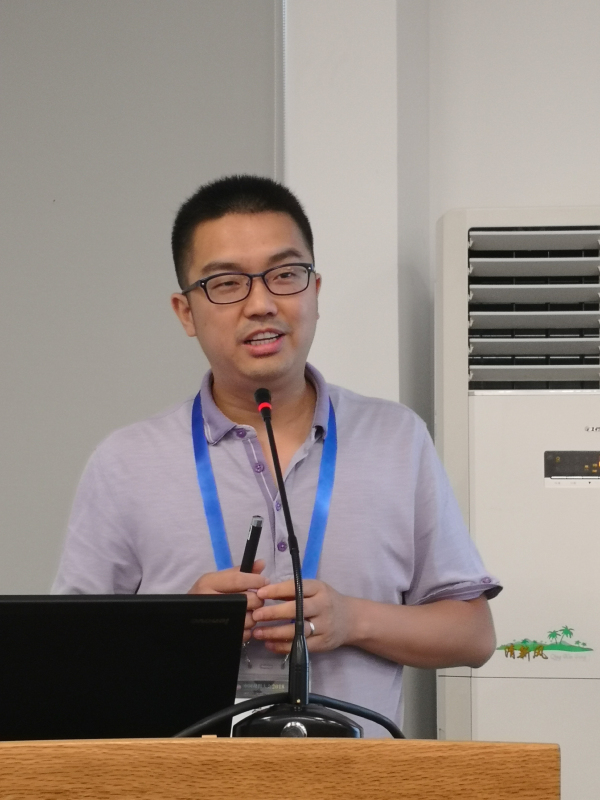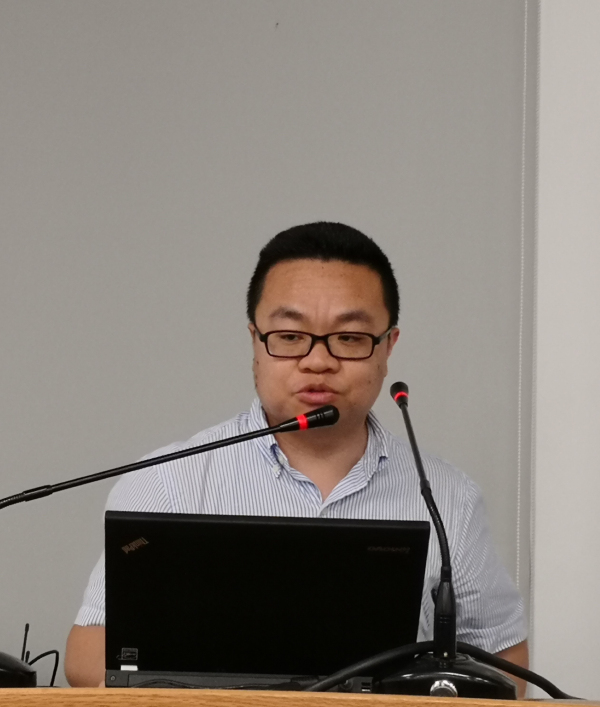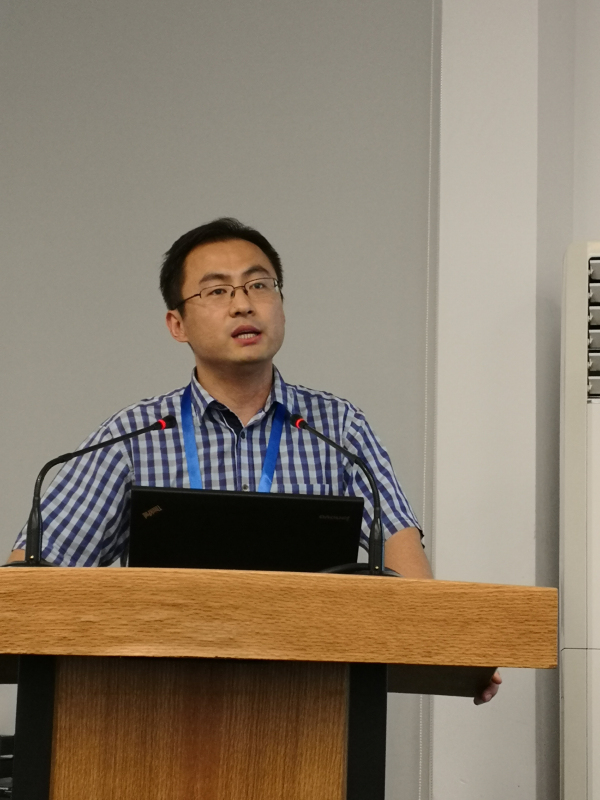From July 12 to 16, 2018, “Chinese Materials Conference 2018” was grandly held in International Convention and Exhibition Center in Xiamen, Fujian Province. The conference was initiated and sponsored by the Chinese Materials Research Society (CMRS). Han Yafang, Director of the Academic Committee of Chinese Materials Research Society and Secretary General of the Chinese Materials Research Society, presided over the meeting, Wei Bingbo, Chairman of the Chinese Materials Research Society, gave a welcome speech and specially invited many other distinguished guests including Han Jingyi, Deputy Mayor of Xiamen Municipal Government, and member of the Party group, Professor Li Xiuzhen, President of International Union of Materials Research Societies (IUMRS), Prof. OsvaldoNovais Oliveira Jr, Chairman of Brazilian Materials Research Society, and Prof. R. ClaudiaElizabeth, Chairman of Mexican Materials Research Society to deliver speeches. The conference has a total of 34 parallel sessions and 1 material forum integrating the Mainland, Taiwan and Hong Kong. The essay covered energy materials, environmental materials, advanced structural materials, functional materials, and basic research of materials. The material education forum, new materials, new processes and materials testing technology exhibitions were held during the same period. More than 5,500 material professionals from the world's leading universities and research institutes gathered in Xiamen to discuss the latest developments in materials technology and industrial development.
The "Advanced Microelectronics and Optoelectronic Materials Parallel Session" sponsored by the Integrated Circuit Materials & Components Industry Technology Innovative Alliance, and jointly supported by Shanghai Institute of Microsystem and Information Technology, Chinese Academy of Sciences, and Beijing Multidimensional Electronic Materials Technology Development and Promotion Center was held during the same period. Academician Wang Xi, Director of Shanghai Institute of Microsystem and Information Technology, Chinese Academy of Sciences, served as Chairman of the "Advanced Microelectronics and Optoelectronic Materials Parallel Session", and Wang Zhengping, Academician of Chinese University of Hong Kong served as Honorary Chairman of the parallel session, Yang Deren, Academician of Zhejiang University, Dr. Lin Qinghuang of IBM and Zhao Chao, Researcher of Institute of Microelectronics of Chinese Academy of Sciences jointly served as the Vice Chairman of the parallel session. Entrusted by Academician Wang Xi, Researcher Zhao Chao, on behalf of Academician Wang Xi, gave an opening speech at the parallel session. The "Advanced Microelectronics and Optoelectronic Materials Parallel Session" has 3 keynote speeches, 11 invited reports, 24 oral reports, and 15 wall newspapers. The reports covered various fields in the field of microelectronics and optoelectronic materials, including new storage materials PCRAM, such as RRAM and STT-MRAM, substrate materials such as Ge, Si, SOI, GOI and compound semiconductors, new display materials and other materials used in the manufacture of integrated circuits and optoelectronic devices, advanced packaging materials, carbon-based functional materials such as carbon nanotube and graphene, new two-dimensional materials such as CN3, material detection techniques and methods, material design theory and computational simulation, etc.
Professor Guo Haozhong from National Chiao Tung University of Taiwan gave a keynote speech titled “Research on the Reliability of Using Quantum Dots to Improve the Full Color of GaN Microdisplays”. In the report, Professor Guo mainly introduced the following five parts: 1. The light extraction efficiency of GaN LED light-emitting diodes is improved and the Droop phenomenon is improved; 2. The micro-LED structure using nanorods; 3. The electric pump blue light VCSEL design and growth in MOCVD; 4, the first quantum dot active region technology to overcome GreenGap's green VCSEL; 5, for blue light laser for visible light communication. Professor Guo Haozhong gave a detailed introduction to the application challenges of lighting products, the internal quantum efficiency and light extraction efficiency of LEDs and the physical mechanism of their efficiency reduction. The methods and ideas for reducing or eliminating LED efficiency reduction were pointed out. Professor Guo believes that due to its high brightness and high efficiency, MicroLED is promising as a key technology to completely subvert the existing competitive landscape in the display field, and will be the first to be applied to the screens of smart watches and augmented reality systems.
Professor Xu Jianbin from the Shenzhen Institute of Advanced Technology of the Chinese Academy of Sciences gave a keynote speech entitled "Flexible Thermally Conductive Substrate Materials and Their Applications in Heat Dissipation of Flexible Electronic Devices". Professor Xu believes that with the miniaturization and multi-functionalization of electronic devices, high-heat-conducting flexible substrate materials will play an irreplaceable role in heat dissipation of flexible electronic devices. Professor Xu introduced the research progress of the team in the thermal conductivity of flexible organic substrates. In response to the key scientific issues of heat transfer of organic substrate materials, Professor Xu has greatly improved the thermal conductivity of flexible organic substrate materials through electrospinning, biomimetic engineering and interface engineering ideas, and prepared flexible, high thermal conductivity and low dielectric epoxy fiber membranes. It is expected to replace the traditional flexible substrate and is expected to be applied to the substrate material of the next generation of flexible electronic devices.
The researcher of Song Sanwei, a researcher at the Shanghai Institute of Microsystems and Information Technology of the Chinese Academy of Sciences, gave a keynote speech entitled "High-speed, low-power phase-change storage materials and applications". Dr. Song believes that with the rapid development of smart phones, Internet of Things, large data centers, smart cars, artificial intelligence, the memory market will become larger and larger, and phase change memory is the most potential next-generation storage technology. Dr. Song introduced the team led by researcher Song Zhijun in recent years in the development of new phase change materials, high-speed reversible phase change mechanism of phase change materials, single-phase process development of phase change materials, phase change memory process integration and phase change memory product development. jobs. The development process of Sc-Sb-Te, the fastest phase change material in the world, and the generation process of phase change octahedron theory are introduced. It is a good reference for material researchers. Dr. Song believes that phase change memory will definitely enter the market with mainstream storage technology, affecting people's daily lives.
Prof. Zhao Yusheng from Beijing University of Aeronautics and Astronautics studied the magnetic anisotropy energy of different overcoat metals in magnesium oxide/cobalt iron boron/heavy metal structures in the invitation report of “New Ultra High Tunneling Magnetoresistance STT-MRAM”. Choosing the right heavy metal will greatly enhance the perpendicular magnetic anisotropy of the structure. For the first time, the pure current driving magnetic moment reversal is realized in the tungsten magnetic layer of the tungsten insertion layer. The experimental results and theoretical analysis show that the single layer tungsten is of great significance to the high performance vertical magnetic tunnel junction, and the new ultrahigh tunneling magnetoresistance STT will be - The development of MRAM laid the foundation.
Prof. Chen Jiezhi from Shandong University introduced the core mechanism of the reliability problem of 3D flash memory in the invitation report of “Research on Reliability of 3D NAND Flash Memory Charge Storage Layer”, and focused on the lateral charge related to data retention characteristics in the charge storage layer from the atomic layer. Diffusion has been studied in depth and found that although hydrogen atom passivation can effectively eliminate shallow level traps, the intervention of excess hydrogen atoms will produce other shallow level traps. On this basis, the stability of hydrogen bonding is further studied, and the correlation between the change of characteristics and the hydrogen bond cleavage during the erasing of the three-dimensional flash memory and the possibility of further process optimization are pointed out.
Associate Professor Zhang Xiaoyu of the National Nanoscience Center introduced the research progress of the interface charge motion in some ultra-thin film systems in the invitation report of “Charge Behavior of Ultrathin Film Interface”. By combining the experimental results and calculations, it is found that the interfacial charge transfer of organic semiconductors, especially ultra-thin organic semiconductors (several nanometers thick), effectively doping the semiconductor, introducing new impurity states near the Fermi level, thus affecting the loading. The transport of the flux in turn affects the thermoelectric effect. In addition, the in-situ detection of oxygen ion motion in the memristor is realized at the microscopic scale, so that the operating mechanism of the oxygen vacancy conductive filament is clarified experimentally for the first time. The research method provides a high-precision and universal method for the movement of ions in solids, which can be widely applied in solid-state systems such as lithium batteries, solar cells, sensors, etc., for the deep understanding of the ion-related microscopic processes in these systems. Provide new research ideas.
Researcher Sun Rong from the Shenzhen Institute of Advanced Technology of the Chinese Academy of Sciences gave an invitation report titled “Research and Application of Advanced Electronic Packaging Materials”. Researcher Sun Rong believes that as the package form transitions from two-dimensional to three-dimensional, it is moving toward higher density. The development of integrated circuits relies in particular on innovative breakthroughs in advanced electronic packaging technology. Therefore, advanced electronic packaging materials will play a vital role. Researcher Sun Rong outlined the progress made by the team he led in the basic research and application of polymer electronic packaging materials. The research team of Sun Rong has condensed the scientific issues of electrical, thermal and mechanical aspects of electronic packaging materials, and aimed at breakthroughs in key technologies. He adhered to the complete work of materials-process-devices and carried out a series of basic research on polymer electronic packaging materials. Industrialization, researcher Sun Rong believes that related basic research and industrial chemicals provide raw materials and solutions as a localization of high-end electronic packaging materials.
Researcher Luo Jun of the Institute of Microelectronics, Chinese Academy of Sciences, in the invitation report of “Application of Pre-Amorphization Process in Advanced Titanium Silicide Contact Technology”, through systematic and meticulous research work, studied the pre-amorphization of device electrical The effect of properties has been found to be that the pre-amorphization of yttrium not only promotes the reaction of ultra-thin titanium-silicon compounds, but also contributes to lowering the contact resistivity, and can be widely used in sub-16/14 nm devices.
Dr. Wang Guilei from the Institute of Microelectronics, Chinese Academy of Sciences, in the invitation report on "Extension and Bonding of Ge and GOI Materials and Their Applications", introduced the high quality of epitaxial growth by chemical vapor deposition (CVD) on 8-inch silicon substrates. The Ge material is formed into a strain-strained sGOI (Strained GeOn Insulator) substrate by a bonding and thinning process. The prepared high-quality sGOI substrate has a surface defect density of 106cm-2, and after surface treatment, the roughness is less than 1nm. The PL film in the GOI is analyzed by the strain change of 0.7 ev. The transistor has been tested to verify high carrier (hole) mobility. The sGOI substrate can be applied to the fields of manufacturing high-energy photodetectors and high mobility transistors in the future.
Prof. Mei Yongfeng from Fudan University presented the research results of strain-based engineering and self-assembly of silicon germanium nano-film materials in the invitation report of “Flexible Silicon Thin Film Materials and Three-Dimensional Devices”. The excellent bending properties allow the film material to be bent in a large scale in the micro-nano range by assembly and self-assembly, thereby forming a three-dimensional structure, such as a mesoscopic structure such as a coiled tubular shape or a pleated shape. This engineering from two-dimensional assembly to three-dimensional structure can acquire new physical properties (mechanics, optics, electricity, etc.), thus providing a high-quality platform for frontier research such as detection, energy harvesting, bio-integration, and flexible electronics.
Professor Pi Xiaodong from the Semiconductor Silicon Materials Research Team led by Academician Yang Deren, State Key Laboratory of Silicon Materials, Zhejiang University, gave an invitation report titled “Silicon Nanocrystals: An Important Silicon-Based Optoelectronic Material”. In his report, he pointed out that silicon nanocrystals are an important silicon material on the nanometer scale. They are non-toxic, low-cost and highly stable. They have the novel electronic and optical properties not found in traditional bulk silicon materials, and are expected to expand significantly. The application of silicon materials in the field of optoelectronics. Professor Pi Xiaodong introduced the cold plasma preparation methods of silicon nanocrystals they have developed in recent years, especially the effective doping and surface control of silicon nanocrystals. Their work has significantly improved the light absorption and light emission properties of silicon nanocrystals, not only promoting the application of traditional silicon nanocrystals in light-emitting devices and solar cells, but also developing high-performance photodetectors and photovoltaics for silicon nanocrystals. New applications in synaptic devices demonstrate the robustness of silicon nanocrystals as an important silicon-based optoelectronic material.
Dr. Chen Kaixuan, CTO of Dry Photoelectricity, introduced the trend of miniaturization of LED backlight chips and display chips in the invitation report of "LED chip miniaturization trend and technology", and pointed out that Mini-LED will become the magic weapon for LCD industry to fight against OLED impact. Micro-LED will likely become the key to completely overturning the existing competitive landscape in the display field. Dr. Chen Kaixuan also dissected several major technical difficulties of Mini-LED and Micro-LED, and shared the situation of Mini-LED and Micro-LED chip technology researched by Dry Photoelectric.
Professor Hao Xiaotao from the School of Physics, Shandong University introduced the key scientific issues, technical difficulties and future development trends in the field of organic solar cells in the invitation report “Adding Insulating Resins to Improve the Performance of Organic Photovoltaic Devices”, focusing on the stability and orientation of organic photovoltaic devices. The solution to the problem of large thickness of printing, and the introduction of insulating resin in the active layer of the device as a third element to effectively suppress the generation of aggregates, improve the thermal stability of the device, and obtain specific research work for high efficiency and large thickness prototype devices.
In addition, Professor Li Fengqi from Jinan University, Professor Hu Pingan from Harbin Institute of Technology, Professor Yang Zaixing from Shandong University, Associate Professor Lu Jianguo from Zhejiang University, Professor Zhong Zhenyang from Fudan University, Professor Wang Fengyun from Qingdao University, Professor Liao Qing from Capital Normal University, etc. Scholars made wonderful oral reports.
Xue Yuan from the Shanghai Institute of Microsystems and Information Technology of the Chinese Academy of Sciences won the best wall poster of the club. The report of this meeting was very exciting. The atmosphere of the meeting was warm and the audience answered questions. The participants received full exchanges and played an active role in promoting the academic level and technological innovation capability of microelectronics and optoelectronic materials in China. Ms. Han Yafang, Secretary General of the China Society for Materials Research and First Vice-President of the International Federation of Materials, expressed her affirmation of the work of the club and encouraged the branch secretary Song Three researchers to make persistent efforts to organize the next year's branch to further expand the advanced materials and optoelectronics of the China Materials Congress. The influence of material clubs.

Professor Zhao Chao of the Institute of Microelectronics, Chinese Academy of Sciences, on behalf of Academician Wang Wei, gave a speech at the opening ceremony

Professor Guo Haozhong of National Chiao Tung University gave a keynote speech

Professor Xu Jianbin from Shenzhen Advanced Research Institute of the Chinese Academy of Sciences gave a keynote speech

Researcher at the Shanghai Institute of Microsystems, Chinese Academy of Sciences, Song Sanwei, a keynote speaker

Professor Zhao Yusheng from Beijing University of Aeronautics and Astronautics made an invitation report

Professor Chen Jiezhi from Shandong University made an invitation report

Dr. Zhang Xiaoyu, National Nanoscience Center, invited the report

Researcher Sun Rong from the Shenzhen Institute of Advanced Technology of the Chinese Academy of Sciences made an invitation report

Researcher at the Institute of Microelectronics, Chinese Academy of Sciences, invited to report

Dr. Wang Guilei from the Institute of Microelectronics, Chinese Academy of Sciences

Professor Mei Yongfeng from Fudan University made an invitation report

Professor Pi Xiaodong from Zhejiang University gave an invitation report

Dr. Chen Kaixuan, Technical Director of Xiamen Dry Photoelectric Co., Ltd., invited the report

Professor Hao Xiaotao from Shandong University made an invitation report

Ms. Han Yafang, Secretary General of the China Society for Materials Research, encouraged the secretary of the club to work hard for the third year.






